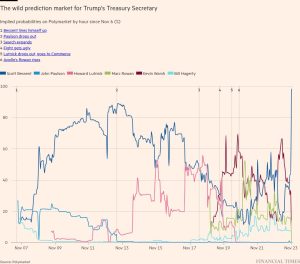Capital gains tax: a short history

Rachel Reeves is considering raising UK capital gains tax in her Budget on October 30. By doing so, she would be following in the footsteps of a long line of British chancellors who have changed the rate since it was first introduced by Labour nearly 60 years ago.
What level has UK capital gains tax been historically?
Generally, it has fallen between two opposite poles; higher rates with more generous reliefs and lower rates with few reliefs.
The tax was introduced by the Labour chancellor James Callaghan in 1965 at a flat rate of 30 per cent on gains realised on the disposal of assets. It was created to prevent people converting income into capital gains to avoid paying high rates of income tax.
After a period of high inflation in the 1970s, an “indexation allowance” was introduced in 1982 to avoid the taxation of paper gains from rising prices.
In 1988, the first big reform of CGT was undertaken by Conservative chancellor Nigel Lawson who equalised CGT rates with individuals’ marginal income tax rates — the highest of which was 40 per cent at the time.
However, Lawson’s reforms also introduced generous reliefs, including a rebasing of assets to their market value in 1982, in order to cushion the effect of the rate rise, and introduced reliefs for small business owners on retirement.
Another big reform came in 1998 when Labour chancellor Gordon Brown scrapped indexation relief, arguing it was unnecessary in a low-inflation environment.
Instead, Brown introduced a new system called “taper relief”. This sought to encourage investors to hold assets for longer, particularly shares in businesses, and taxed them at successively lower rates the longer the length of ownership.
When Labour’s Alistair Darling took over from Brown in 2008, he scrapped the relief and instead levied CGT at a single flat rate of 18 per cent for individuals and a 10 per cent rate for some business owners. The latter became known as entrepreneurs’ relief and is now referred to as business asset disposal relief.
Under the Tory-led government coalition with the Liberal Democrats, the chancellor George Osborne raised the CGT rate to 28 per cent for higher-rate taxpayers in 2010.
What has the UK’s policy been more recently?
In 2016, Osborne cut the rate for most assets (apart from carried interest and certain residential property) to 20 per cent for higher-rate taxpayers and 10 per cent for basic-rate taxpayers. Earlier this year, then-chancellor Jeremy Hunt lowered the residential property rate from 28 per cent to 24 per cent.
CGT is currently charged at the rate of either 10 per cent or 18 per cent for basic rate UK taxpayers. For higher or additional rate taxpayers, the rate is either 20 per cent or 24 per cent. Carried interest is charged at 28 per cent.
But since about 2010 the divergence between gains declared and tax paid has widened substantially. Tax experts said this could be due to a number of reasons, such as the stripping out of indexation relief and increases in the annual exemption allowance, which rose from £10,100 in 2010-11 to a peak of £12,300 in 2022-23. It has since been cut to £3,000.
How do other countries tax CGT?
Most countries in the OECD group of wealthy nations have CGT rates significantly lower than their income tax rates — a pattern the UK conforms to.
Across the world CGT is levied in various ways, with specific reliefs and exemptions applied to different types of assets, holding time and transactions.
For instance, the highest tax rate on capital gains in Australia is 45 per cent (the top income tax rate). But the regime also allows for a 50 per cent discount on the gain for assets held for more than 12 months.
The US charges CGT at a headline rate of 20 per cent, however, most pay at 15 per cent if an asset is held longer than 12 months.
Other countries make use of features that were historically part of the UK system, such as France, which has a taper relief for property that is dependent on length of ownership, or Portugal, which has an indexation allowance on property in certain circumstances.
Nordic nations typically have some of the top CGT levies, with Denmark’s rate of 42 per cent among the highest in the world.
Meanwhile, several jurisdictions, including the Bahamas, Belgium, Bermuda, the Cayman Islands, Gibraltar, Hong Kong, Jersey, Guernsey, the Isle of Man, the Netherlands, New Zealand, Qatar, Saudi Arabia, Singapore and the UAE, do not charge CGT at all.
“[CGT] is not a huge amount of any country’s tax take,” added Elsa Littlewood, partner at BDO.
What happens when governments raise rates?
Even the rumour of rate rises has been shown to trigger a sell-off of investments or assets, Littlewood said, pointing to official statistics last month that showed that CGT receipts in August were the highest received in that month for several years.
In contrast, when higher rates are actually in place it has tended to result in fewer people selling assets, to avoid paying tax at the higher rate.
John Barnett, chair of the technical policy and oversight committee of the Chartered Institute of Taxation, a professional body, said the Lawson CGT regime “arguably restricted entrepreneurship”.
“It definitely led people to leave the country, go off to Belgium or Portugal, say, to realise gains and then come back. It meant that people hung on to things and didn’t sell them, which was bad for tax receipts and the economy,” he said.
“If you tinker with CGT there’s more chance for behavioural change [from taxpayers],” added Emma Rawson, technical officer for the Association of Taxation Technicians.
And what is the effect of lowering them?
One senior adviser said that generally lower rates have brought in more CGT revenue. “The Lawson period had relatively low CGT paid compared to the Brown period,” they noted.
However, an OECD working paper found that across the OECD the empirical evidence was not so clear-cut. “Changes in the tax rate or anticipated changes have coincided with large increases in capital gains realisations, but realisations quickly fell back to previous levels,” it concluded.
In 2010, Osborne told parliament the Treasury had produced an analysis that showed an optimum CGT rate of 28 per cent.
More recently Conservative officials told the FT a rate of 24 per cent on property was considered the peak of the CGT Laffer curve, the point at which increased taxes will depress economic activity and lead to a lower overall yield.
Some tax experts think that because of these risks Reeves will not seek to raise the rate much higher than it currently stands.
“In the UK’s tenuous situation in a post-Brexit, post-Covid world, it’s a really very challenging policy to be playing around with,” said Daniel Bunn, president and chief executive of the US-based Tax Foundation think-tank.
#Capital #gains #tax #short #history









